[SSI, Apple II]
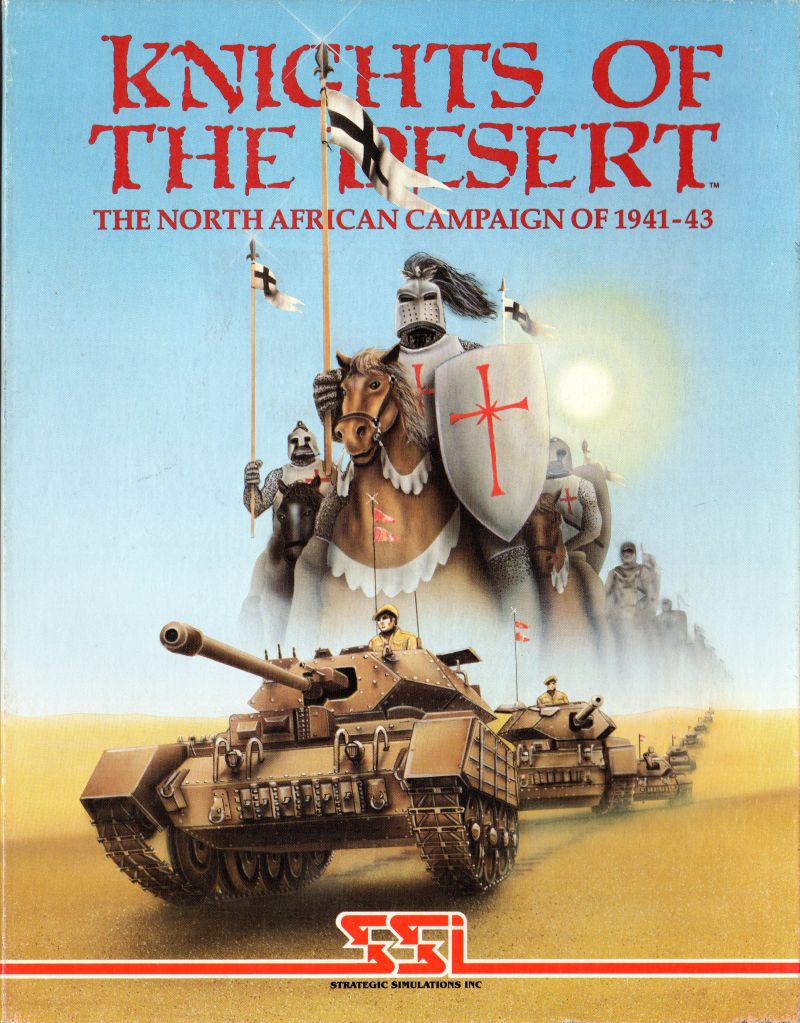
Never before had such a war been fought. Never again would such a war be possible. It was as if the gods had looked down on this puny creature man, with his war-like dreams of glory, his monstrous, proud machines, and then said: go for it! If that’s what you want, then here’s your chance to show what you can do (perhaps your last chance before you have so much power that there can be no glory in its use). For once, then, let there be a marriage of medieval man and modern machine. For once let brazen knights, pennants raised and flying in the desert sunlight, spur their armored steeds across the blazing sands. Let Greek and Trojan pause in frozen battle to stare in awe and see themselves surpassed in spectacle for song and story.
And so the gods picked man up, with all his treasured playthings – his trucks, his tanks, his armored cars, his guns, his planes, his mountains of bombs and shells and ammunition – and set him down in a barren land where he could no little harm to anyone or anything else, and turned him loose in the desert sun.
Robert S. Billings – Brazen Knights and Blazing Sand
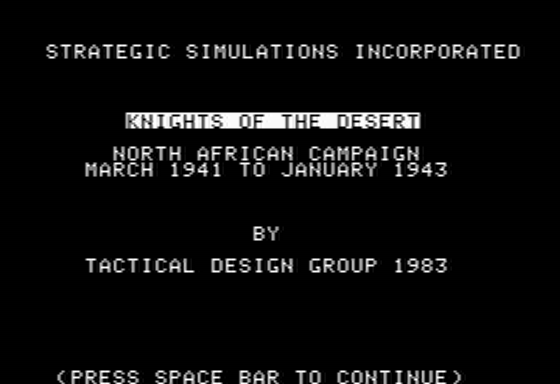
On the 7th of February 1941, the British Western Desert Force led by General O’Connor had achieved the impossible : with 36 000 men he had attacked, defeated and forced to surrender an army of 150 000 Italians, losing less than 2 000 men in the process. The last remains of the Italian colonial Empire was virtually defenceless. Alas, the victorious march to Tripoli would have to wait. One week after the astonishing victory, Churchill decided that the British veterans would be redeployed in Greece, just as the first units of the Deutsche Afrika Korps (DAK) were landing in Tripoli. Fate had decided to distribute a new deck of cards.
Knights of the Desert is the fourth game by the Tactical Design Group duo (David Landrey and Chuck Kroegel). This time, I play Rommel as he launches the Axis counter-attack East. My objective is simple : my Italo-German forces start in the bottom-left corner of the map and I must bring them to the top-right of the map to Alexandria, or as close to it as possible. To make things even simpler, there is only one road which follows perfectly the coastline and connects the few towns and cities represented in the game.

March 1941 : Panzer for Tobruk
The campaign starts in March 1941. I start with 2 elite German units (a panzer division and a mechanized infantry regiment), one solid Italian unit (the Ariete armoured division) and 7 other Italian units rating from “average” to “mediocre AND totally depleted”. In addition to this, I have 6 logistical units (called “depot”) and a garrison in El Agheila which is considered the Axis home base in the game.

Tactical Design Group‘s WW2 games have always been about managing supplies and reinforcements, and again the first decision I have to take is resource allocation :
- Supply is the easiest to allocate : right now there are enough to fill-up every unit up to its maximum, and it is better to do it now rather than later as the supplies actually received by the units decrease by 1% per hexagon away from the home base.
- On the other hand, there is only limited replacement available, so I limit it to the good units, and keep a small reserve of specifically Italian replacements for the future.
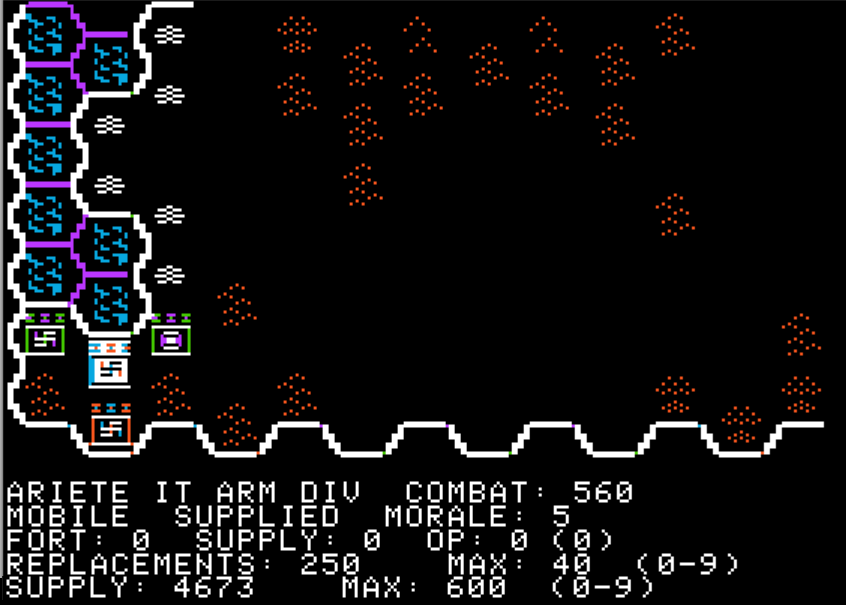
It is time to take my force to Tobruk, a particularly strategic location as it gives a massive defensive bonus and even more importantly serves as a supply source. While my soldiers are still discussing the seating arrangement in the trucks, I face a first obstacle : an armoured division and its depot battalion starting the campaign directly in contact with my force.
I want to defeat this token force with my Italian infantry, so my more mobile units keep enough movement points to beeline to Tobruk before it gets reinforced. I try to surround the enemy… and the Allies immediately receive a “reaction phase” (more on this later) and move their tanks away.
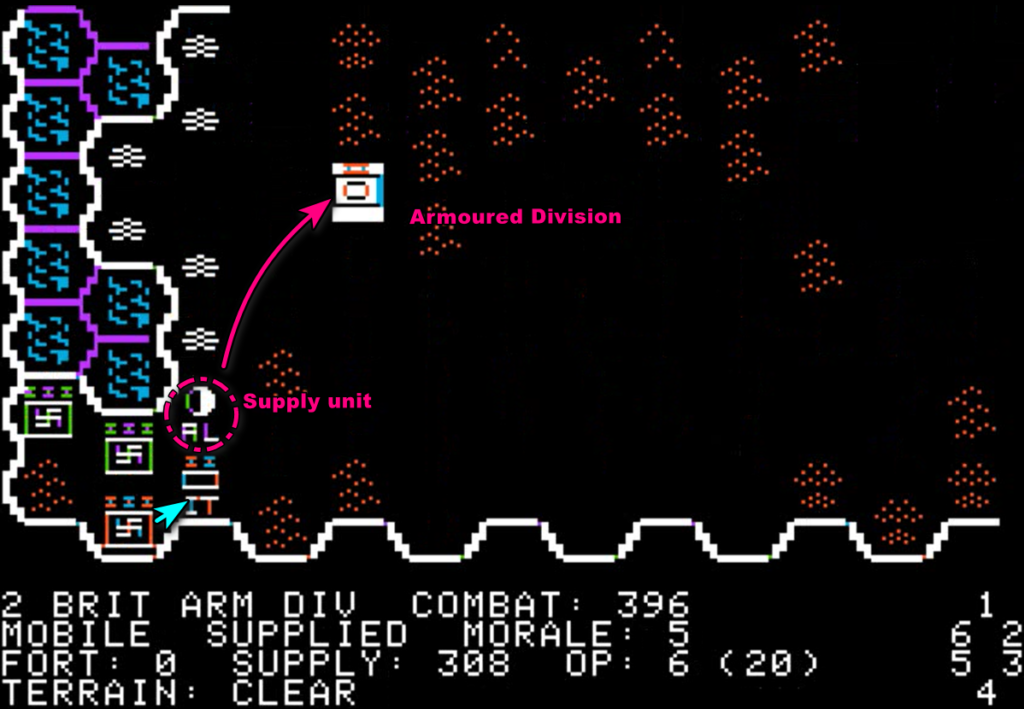
The depot battalion can never be moved during a reaction phase, so my infantry did not do all sorts of tactical shenanigans for nothing : they valiantly defeat a mixed enemy force of fuel trucks, food carts and cook infantry. The Italians keep the fuel, burn the British food and let the British “cooks” go back to their lines. The British depot unit will be recreated around a cadre of survivors ; for now it is out of the way.
My infantry follows the road up to Benghazi, where they find and destroy another British depot. Population cheers as the Razione Giornaliera replaces the British Composite Ration in the local markets.
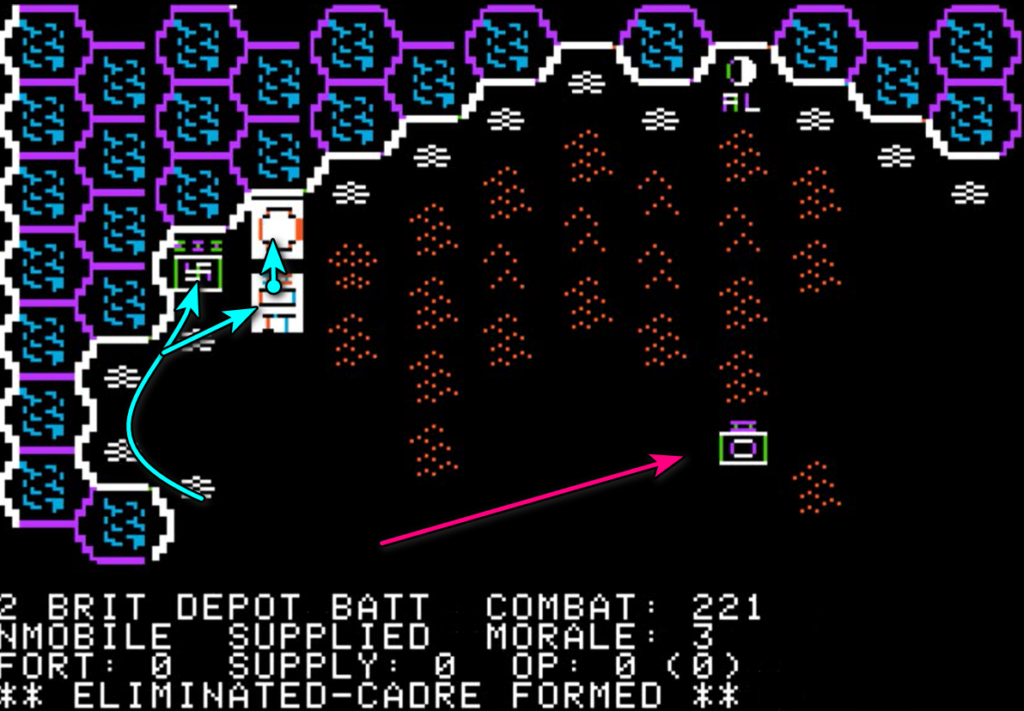
Units can move very fast when using the road, so I reach a third enemy depot. This time, I order my mobile units to go a bit off-road to be able to totally surround the depot. Surrounding an enemy gives a large combat advantage and prevent it to reform if destroyed. The depot is captured and the prisoners watch in stunned silence hundreds of tons of haggis being dumped into the sea.
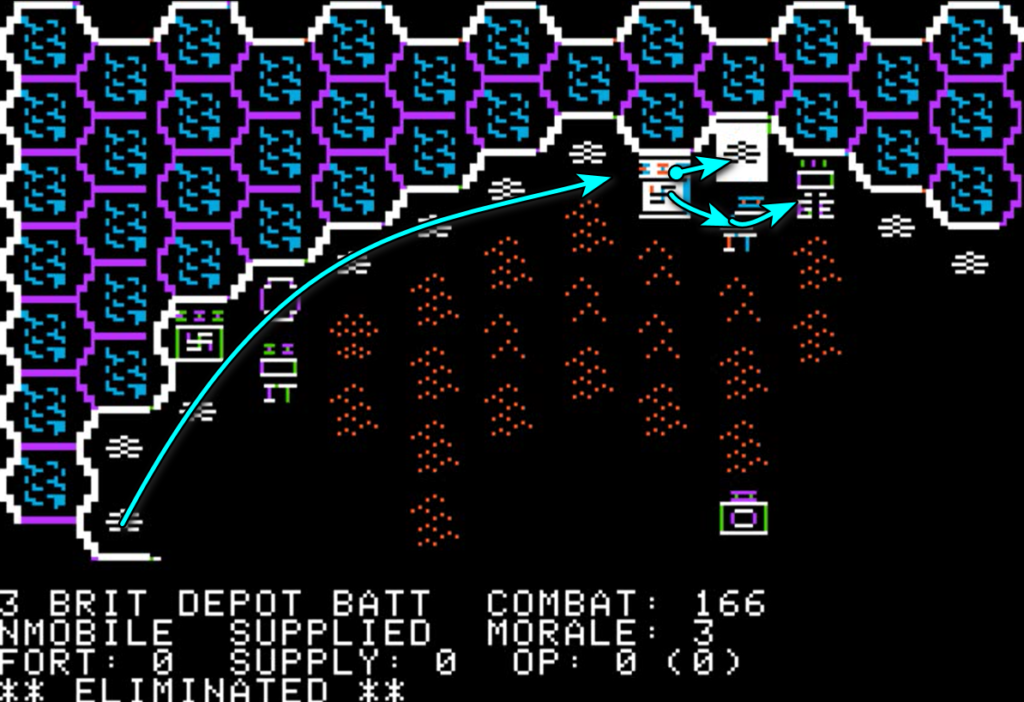
And then I reach the outskirts of Tobruk with my tanks !

I move my depot units to keep my unit supplied, and end there my operation phase.
Is my turn over ?
No !
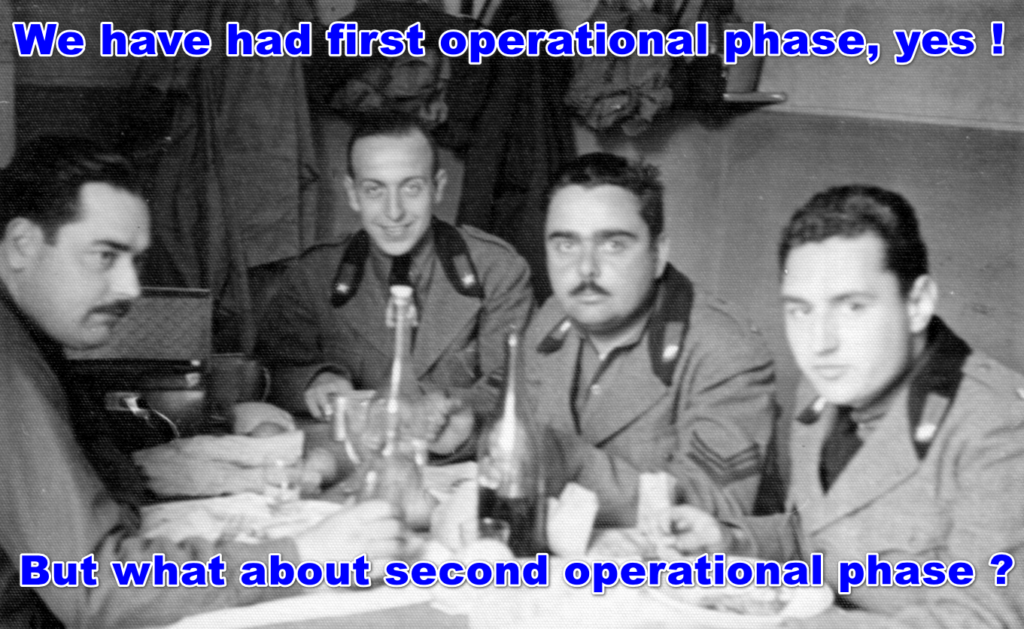
In Knights of the Desert, turns are complicated. For the purpose of this AAR, let’s say that
- there is an Axis “segment” and an Allied “segment”
- the segments are divided in 7 (seven !) phases, including two “operational phases” at the start of which the active player receives a full refill in movement points but not supplies,
- the inactive player has reaction phases during the opposing player’s segment, which is always triggered at the end of the first operational phase but can also be triggered by event (typically an opposing unit occupying an empty adjacent tile). The kicker : the inactive player has refilled their movement points at the beginning of the turn of the active player, but they will not get any other refill for the duration of both of the active player’s operational phases.
tl,dr : it is my turn again, and this time the British are out of movement points to react. I surround Tobruk and prepare for the attack :
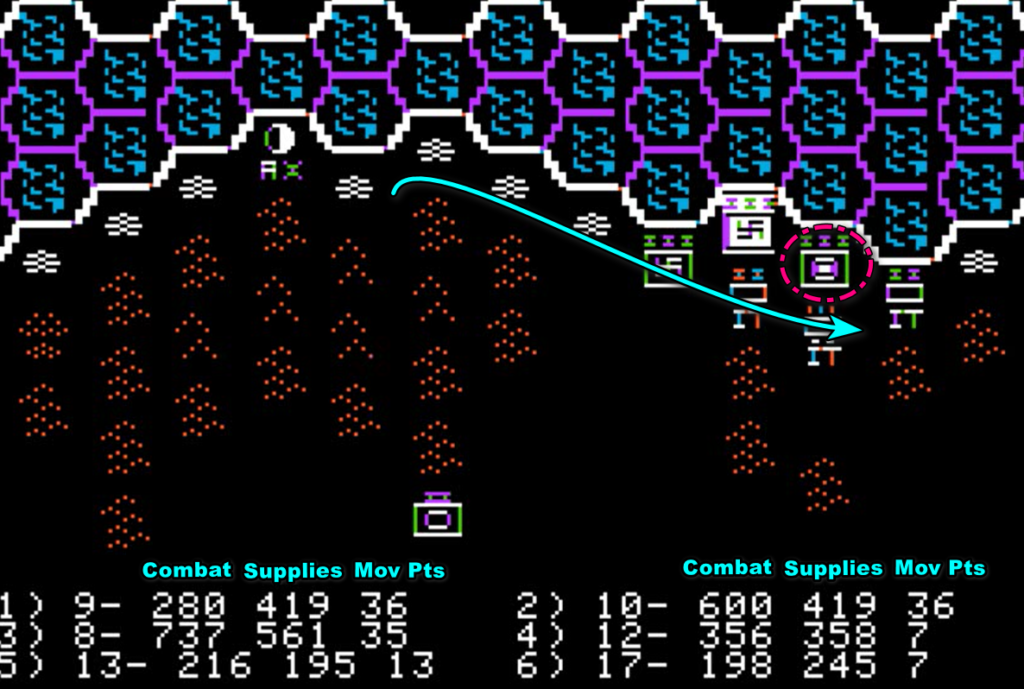
Tobruk is defended by an Indian infantry division and an Australian infantry division. Each unit surrounding Tobruk gives me an attack bonus of 400 combat power, but the Allied units fight at triple their nominal combat value in the Tobruk fortress, plus an extra bonus for being several units in the same hex. It will be bloody.
In Knights of the Desert you can focus your attack on individual units in a hex, so I pick the weakest unit – the Australian division – and I go all in, exhausting men and supply. I destroy it, but I am all out.

Well, that’s all for my second operation phase. The Allies don’t have much to do during their turn, and I am all short on supplies so little else happens during the rest of the turn.
May 1941 : Decision in the Desert
The Allies are playing first, and they have just received reinforcements, so it is my time to be on the receiving end. The Sabratha Infantry division holding the Eastern side of Tobruk is the first unit on the way of the Commonwealth, and it does not go well for them :
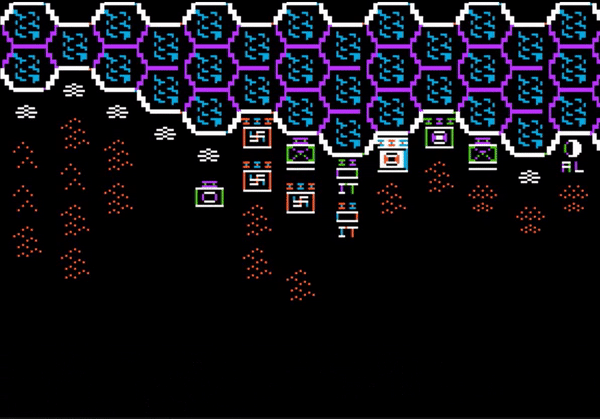
The British are going to be able to reinforce Tobruk, and I need to act now. I use my reaction phase to attack with everything I have :
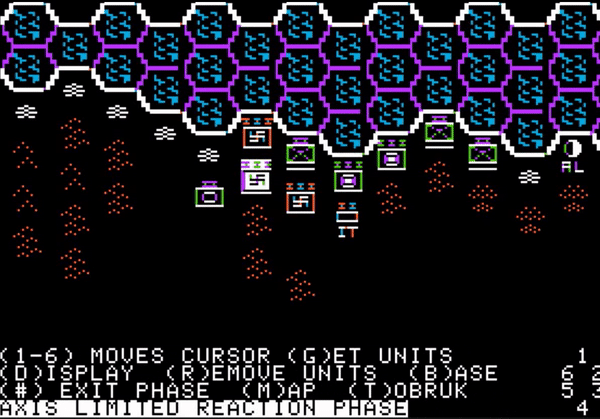
Victory ! Of course, with Tobruk not surrounded, the Indians are able to reform their unit, but that’s a problem for future-Rommel. For now, I am in Tobruk.
The British realize they have to counter-attack Tobruk now before I can fortify, and they launch everything they have at Tobruk by regrouping 6 units in a megastack. They destroy one of my defending two units (the Savona infantry division – it will come back), but the second one survives. Barely survives yes, but that’s enough.

With what’s left of my movement points, I encircle the exhausted megastack of 6 units !
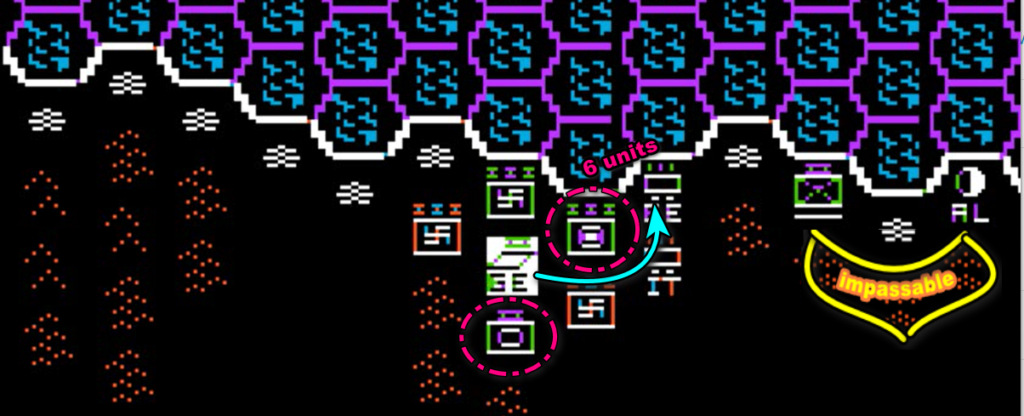
The British have received 10 since the beginning of the campaign but with 1 unit destroyed, 6 surrounded and 1 isolated, they really don’t have much to work with anymore. I spend the rest of the turn reorganizing my siege and digging in : the elite German units (including a newly received Panzer division) block the retreat to the East while the sturdy Trento division fortifies in Tobruk
July 1941 : Holding the line
For the first time, I cannot resupply fully this turn, so I give the highest priority to the German units, the Ariete division and the Trento Division. The rest of the Axis divisions will have to do with what they have left.
At least, I receive some supplies – a luxury most of my opponents don’t have. 7 of the now 11 Allied units receive nothing, even though they could easily have. If the AI had moved one of its depots one hex to the right, it would have been able to supply the Allied megastack, surrounded or not !

The Allies start again, and with what’s left of their supplies the megastack assaults Tobruk again, hoping to take the fortress and from there rely on the port. I exhaust my air support in defence, and Tobruk holds two more rounds of combat, each of them triggering a reaction phase. That’s why I needed to reinforce Tobruk with yet another German unit I just received, and that’s the end of Britain’s hope to salvage the situation. All their surrounded units are now below 200 supplies, and below that threshold (100 for the Axis), they can’t attack anymore.
Now I just have to wait for it to wither and die by lack of supplies : units consume 100 supplies by turn and disappear forever if they cannot pay this maintenance cost. As they can’t attack, I can even free my elite units to easily finish off the isolated armoured division, allowing me to consolidate a bit the front :

September 1941 : Jumping the line
I don’t receive a lot of supplies in September, but I have not consumed a lot either in the previous turn so the situation is still solid, and I can keep my mobile units fully supplied. They will need it.
Once the Allies have wasted their movement points in pointless attacks, I take my best panzer division, go through the Southern desert and fall on a British depot, attacking it with overwhelming force…
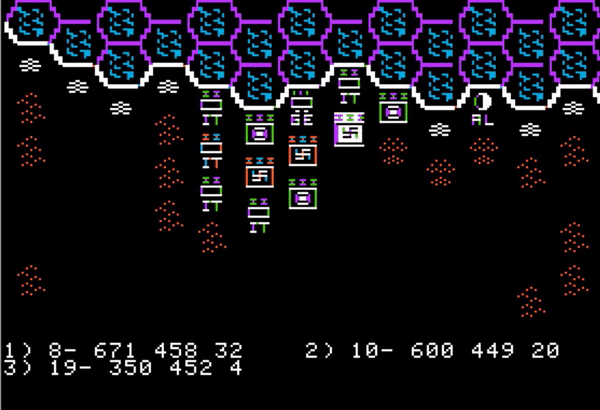
… and failing to destroy it.
I bring a second panzer division, and it also fails to destroy the enemy depot.
Finally, I bring the Ariete division, and nothing can stop the Italians in their quest to destroy terrible British food. The depot unit is annihilated – and more Allied units are surrounded.
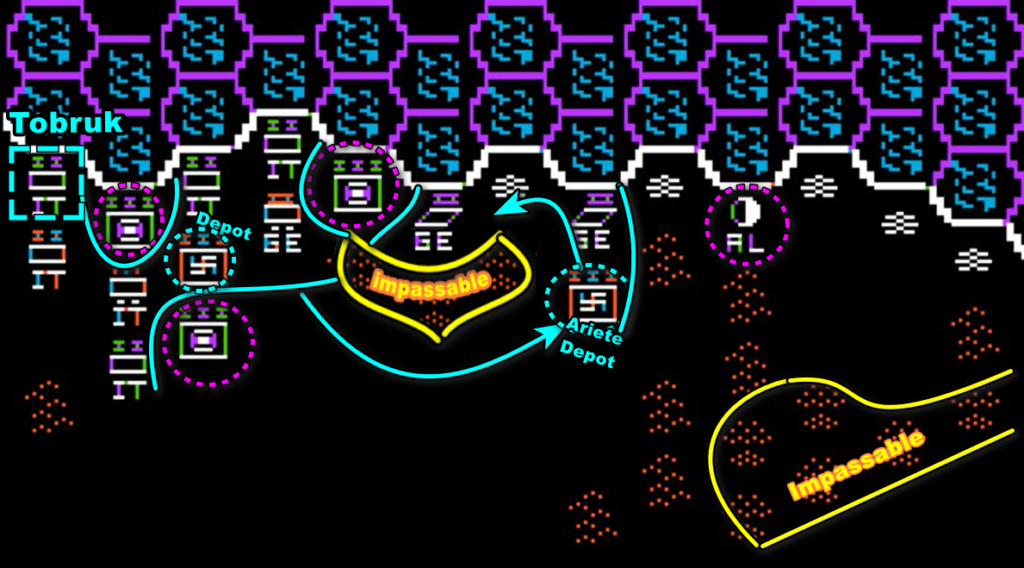
November 1941 : The beginning of the end
The turn starts poorly for the Allies :
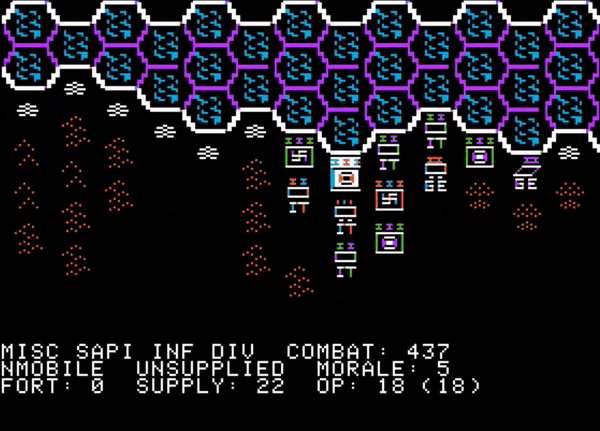
6 units gone, out of the 13 combat units the Allies have received since the beginning. 2 more have been destroyed earlier on. Out of the 5 remaining, 2 more are surrounded, and 2 are out of supply and out of position. Everyone can see the writing on the sand.
I focus on the two surrounded units blocking the way, and destroy them, then easily surround the new unit the British just received, destroying one more supply depot. I also block the retreat of the British infantry that advanced too much.

January 1942 : The middle of the end
This turn, I play first. I also receive a record volume of supplies and replacements – more than what I need.

I attack the surrounded units just enough to drain their supplies, and then I pushtoward Alexandria, wiping out the few reinforcements the British receives, including some hapless Free French. Alexandria is surrounded, with the remaining British depot units having fled inside, preventing more useful units from spawning :

March 1942 : The end of the end
… and as expected :
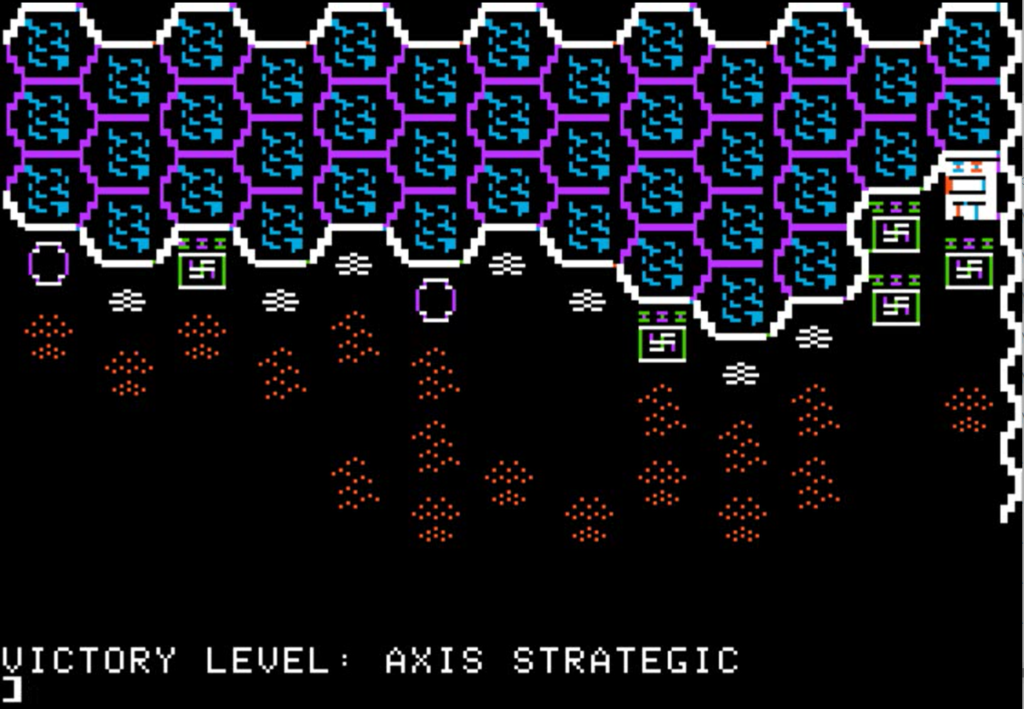
This is my first decisive victory in a Tactical Design Group game, AAR or not. Also, the first time I had some fun in a Tactical Design Group game, but more on this below.
Rating & Review

Knights of the Desert by Tactical Design Group, published by SSI
First release : April 1983 on Apple II, Atari 8-bits and TRS-80
Tested on : Apple II emulator
Total time tested : 8 hours
Average duration of a campaign : 3-4 hours for 12 turns
Complexity: Average (2/5)
Would recommend to a modern player : No
Would recommend to a designer : No
Final Rating : Obsolete
Ranking at the time of review : 27/67
After a terrible Tigers in the Snow, a pointless Battle of Shiloh and a frustrating Battle for Normandy, David Landrey and Chuck Kroegel are back for their 4th game about a battle almost everyone has heard about, except this time the game is neither terrible, nor pointless, nor frustrating. Unfortunately, I have not been able to contact Landrey and Kroegel, so I don’t know what triggered the many changes that make Knights of the Desert better
The Tactical Design Group has always been exceptional at porting their games on most available platforms. Knights of the Desert was initially released on Apple II, Atari 8-bits and TRS-80, and later ported to Commodore 64 and IBM PC.
- the Commodore 64 version is very close to the original, but a bit less pretty :
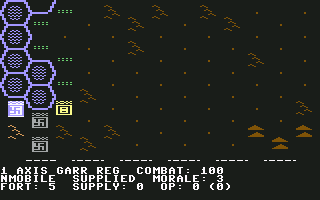
- the IBM PC is also very close to the original, but a lot less pretty :
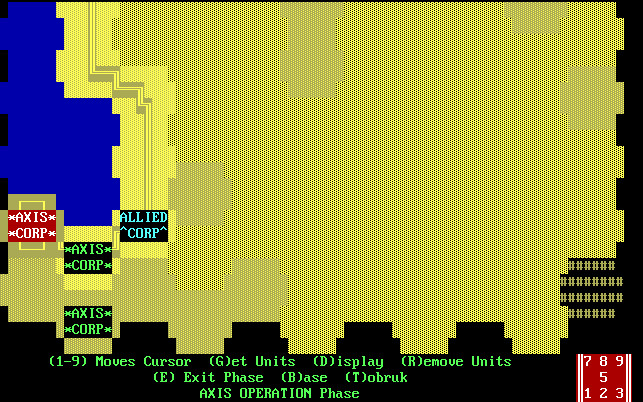
- The Atari version scrolls smoothly à la Eastern Front 1941, and like in earlier games the map is a bit different :

- And finally, there is the TRS-80 version. As usual, it is its own thing :

Speaking of which and as a final trivia, Knights of the Desert would be the last TRS-80 game sold by SSI.

Whatever the version, the game was sold at the usual price for the Tactical Design Group games (39.99 USD) as the content was quite simple : the game, a manual, one sheet with a map on one side and a reference card on the other.
As usual, the review is for the version I played – Apple II.
A. Immersion
The historical context of Knights of the Desert is introduced by a long (11 pages) essay article penned by Robert S. Billings – Joel Billings’s father. The quote I included at the top of this article is the incipit of this essay, which is remarkably well-written but might not exactly fit modern historiography, in particular because it totally ignores the hardships of the local population. Still, the read is both informative and entertaining, and Robert Billings avoids the Rommelomania so common in the 80s.
As for the game itself, Knights of the Desert uses fewer art assets than the earlier Battle for Normandy, but the simple iconography certainly aged better. Yes, of course, it is not pretty by modern standards, but it is clean and that’s probably the best you can ask from a 1983 game.
As usual with the Tactical Design Group, the game comes with a complete order of battle. For the first time, I felt the gameplay leveraged the difference in quality between the different countries and even between different German, Italian or Commonwealth units. This is possibly because units are more mobile in this game than in any earlier Tactical Design Group games, so you are not using in your offensives whatever hapless units happen to be stuck in the enemy’s zone of controls while the rest of your army wait behind.

Rating : Acceptable
B. Systems
Except for that weird turn structure, Knights of the Desert‘s ruleset feels like a streamlined version of Battle for Normandy, with the frustrating complexity removed in favour of a deep but understandable system.
First, let me talk about combat. In Battle for Normandy or the earlier games, combat result was calculated by using a combination of combat power ratio, attacking and defensive strategy, level of risk for both sides, naval/air support and then depending on the specific game some of the following : “fatigue”, “leadership”, “combat state” and/or “morale”. After collecting all those inputs, the game applied some magic and the output was never close to what you expected.
Knights of the Desert gets rid of most of that :
- The attacker chooses an attack intensity, and the combination of this attack capacity, of the air power invested by the attacker and of the sum of the power of the attacking units serves as a baseline for the damage that both sides receive. Note that the more intense the attack, the more costly in movement points and supplies it is,
- For the attacker, this is modified by the morale of the attacking unit (higher morale, less damage),
- For the defender, it is modified by the modified combat power ratio and how much air power is allocated. “Modified combat power“, because the ratio of combat power between the opposing units is modified by the terrain, the level of entrenchment and how many units are surrounding or supporting the defending units. The impact of each of them is clearly explained in the manual.
- Finally, the level of risk just increases the standard deviation around the expected damage.
It is complicated, it is not very intuitive (morale reducing damage ?), but for the first time the impact of each factor is explained in the manual so you have a rough idea about what to expect.

Supply management receives the same simplification. The 3 “supply resources” (“general supply”, “combat supply” and “fuel”) of Battle for Normandy are merged into one (“supply”) and how much you receive or consume does not feel random anymore :
- The Axis receives a fixed amount of supply to their supply reserve every turn, the Allied have an infinite supply reserve,
- If you are the Axis, you pick how much supplies from that supply reserve each of your units receive ; if you are the Allied player each of your units that can be supplied gets the maximum possible,
- Consumption in battle does not depend on which defensive strategy your opponent is choosing,
For the first time in a Tactical Design Group game, I felt like I could make informed decisions on combat and manage my supply.
It is not to say Knights of the Desert is perfect, far from it :
- Combat is grindy as you need to attack again and again and yet again to obtain a decisive result, and if you don’t breach the line early on the game turns into a bloody stalemate reminiscent of Battle for Normandy due to the combination of narrow frontage, high unit resilience, lack of forced retreat and destroyed unit reforming and rejoining the main force in one turn. My AAR did not see much of such combat, but trust me I was lucky,
- Optimising combat requires way too much calculation (“given supply and movement cost consumption of the intensity of attacks, is it better to do 3 attacks at intensity 5 or 2 attacks at intensity 9 ?”) and unfortunately when you reach the kind of bloody stalemate described above optimising combat better than your opponent is the only thing you can do. I don’t play computer wargames to do maths.
- Finally, the supply rules are baffling : surrounded units can still receive their supplies if they happen to be in range of a depot or in range of a besieged Tobruk.
So not great, but still, what a difference with the earlier games !
Rating : Acceptable
C. UI , Clarity of rules and outcomes
The UI is much improved compared to earlier games : you can easily navigate your own units, and you have access at all times to your supply or replacement situation. There are a few issues here and there, but nothing major.
Rating : Quite good
D. Scenario design & Balancing
First, about the AI : the game has a mix of the best and of the worst. The AI usually does not let itself be surrounded, and I believe it only blundered in my AAR because it tried to retake Tobruk – a mistake a human player could have done. Usually, it keeps some units in the back to avoid encirclement, plays conservatively, and actively attacks weak points with overwhelming forces – basically it is more Montgomery than O’Connor. But if you manage to encircle it though, you will probably win : the AI is terrible at managing its supply lines, preferring to let a combat unit rot rather than moving its depot one hex away from its position. That’s probably why in Solitaire you can only play against the Allies.

Knights of the Desert comes with a full range of scenarios, including a one-turn scenario and a three-turn scenario that were perfect for my training. Unfortunately, due to the historical back & forth of the front during the Desert war, the Germans start with all their forces around El Agheila in both the March 1941 scenarios and the January 1942 scenarios so only the El Alamein scenario looks different. Still, with many more Commonwealth units around, the January 1942 scenarios are much harder : Tobruk is impossible to take by surprise and with Tobruk providing supplies to the British it is not possible to starve the Allied units – I am still to win one of those later scenarios.
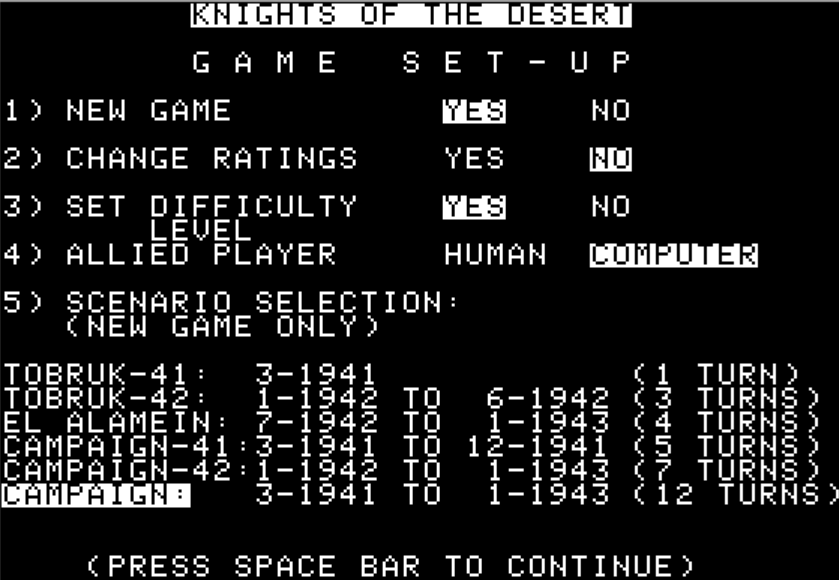
Finally, as is usual with the Tactical Design Group games, there are a lot of options for customisation – I never used any of them.
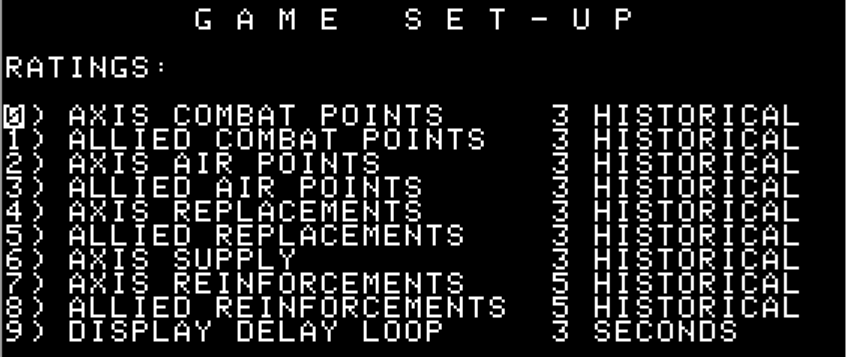
Rating : Acceptable
E. Did I make interesting decisions ?
Yes, mostly tactical ones.
F. Final rating
Obsolete. Knights of the Desert is leagues above the earlier Battle for Normandy and would have been a solid game in 1983, but it belongs to a crowded theme and if you don’t take Tobruk early it becomes yet another grindy game. There have been countless games covering the same aspect of the same campaign, but doing it better, larger (with French North Africa and Operation Torch) and with all the modern bells and whistles. Still, you might not get bored if you give Knights of the Desert a chance and don’t get bogged down in front of Tobruk.
Contemporary Reviews
Knights of the Desert is another game that seemed made for Computer Gaming World, but for some reason the review in July 1983 was respectful but unenthusiastic. Reviewers John Gleason and Ed Curtis described the game systems at length, before concluding : “The game captures the feel of the war in North Africa, is relatively easy to play, and yet contains accurate details of the units involved combined with a reasonable accurate method of calculating the effects of combat. […] KD is another solid step towards the ideal computer wargame.” A solid step, yes, but not yet the ideal computer wargame. Similarly, Softtalk in August 1983 explains the game is a “worthy wargame” after a generally positive review while Softline in November does a bit better by calling the game “exciting“.
Amusingly, the most positive review might be the one from Family Computing in November 1983, with significant caveat : “War games are not for everyone. Some may object to their violent nature, or in this particular case, the reenactment of a Nazi military triumph. But like chess, these games might best be regarded as strategic scenarios. […] Although Knights of the Desert might not appeal to everyone, for gamesters with the appropriate interests and skills, it is a provocative and mind-stretching experience“.
Nonetheless, the game was respected enough to receive the Charles Roberts Awards for Best Adventure Game for Home Computer of 1983, possibly confusing a lot of buyers who expected an amazing verb + noun gameplay. It was also another success for SSI, Landrey and Kroegel with more than 16 000 copies sold in the USA (compared to 18 000 for Battle for Normandy and 19 000 for Tigers in the Snow). It evidently meant there would be another game, and maybe aware that Tigers in the Snow was rapidly becoming obsolete, the designer duo returned in 1984 to the Battle of the Bulge with Breakthrough in the Ardennes.